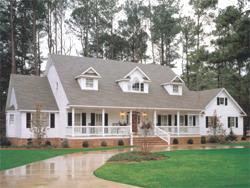Home Renovation Will Slow but Spending Will Continue
Washington, DC, October 31, 2022-The housing market has turned cold, but spending on home improvement appears well insulated for now, reports the Wall Street Journal.
“America’s housing market is getting hammered, and that seems like it should chill the boom in home renovation. But, even though spending seems sure to slow, there is reason to think it might not buckle.
“The rapid ascent in mortgage rates has turned the switch on housing from hot to cold. The number of previously owned homes sold last month was down a seasonally adjusted 24% from a year earlier, according to the National Association of Realtors.
“With Freddie Mac this past week reporting that the average rate on a 30-year mortgage reached 7.08%-the highest since 2002- the strains on housing affordability are only becoming more severe. The drop in home sales takes away a couple of big reasons people fix up their houses. Those looking to sell often spend money on improvements in hopes of making the sales process go more smoothly or fetching a higher price. Recent buyers often spend money on improvements as well to make their newly purchased homes better fit their wants and needs. Researchers at Harvard’s Joint Center for Housing Studies weight existing-home sales heavily in their forecasts of spending on home improvement and maintenance expenditures.
“But rising mortgage rates and fewer moves alone don’t necessarily translate to lower home-renovation demand. In Lowe’s last earnings call, Chief Executive Marvin Ellison pointed to the mid-1990s, when home-improvement spending grew despite rising interest rates and a slowdown in housing turnover.
“There are other factors to consider beyond home sales. The Harvard JCHS forecasting model also includes sales at building-supply stores, remodeling permits, gross domestic product and the Conference Board’s index of leading economic indicators-itself an amalgam of data such as weekly jobless claims and manufacturing orders- as its inputs.
“‘It’s not easy or clear-cut,’ says JCHS senior research associate Abbe Will. ‘We see headwinds, but there are tailwinds too.’
“The JCHS model forecasts that maintenance and improvement spending will grow by 6.5% over the 12-months ending in the third quarter of 2023 versus a year earlier- a sharp deceleration from the 17.8% growth registered during the comparable period that ended in the third quarter of this year, but growth nonetheless. Similarly, a survey conducted by the National Association of Home Builders shows optimism among home remodelers is still running high.
“Home-improvement companies themselves remain bullish even after two years of pandemic-fed growth. Mr. Ellison said in the Lowe’s earnings call that the three factors that have historically correlated most with demand for the company’s products-home-price appreciation, age of housing stock and disposable personal income- remain strong. Home Depot CEO Ted Decker said at a conference last month that customers remain “very healthy,” estimating that U.S. home values have gone up $8 trillion to $9 trillion over the last two years.
“Paint seller Sherwin-Williams, which reported earnings more recently, said it continues to see strong demand from professional customers but was more cautious about 2023, noting that new residential demand is likely to slow.
“One source of underlying demand for home improvement is that, thanks in part to years of underwhelming construction activity, American homes are getting old.
“The median age of an owner-occupied home in 2021 was 40 years, according to the Census Bureau, compared with 29 years in 2000.
“‘The aging home continues to require more remodeling, more updates,’ Sherwin-Williams CEO John Morikis said on the company’s earnings call Tuesday.
“Homes aren’t all that is aging: According to the Census Bureau, 56 million people, or 17% of the U.S. population, were 65 or older as of last year. By 2030 that cohort will rise to 73 million. Many aim to “age in place.” For some that entails moving into a more suitable home, but for others it means remodeling to fit their needs.
“The recently passed Inflation Reduction Act includes fresh incentives for remodelers, including tax credits and rebates for a variety of energy-saving home improvements, such as replacing windows, putting up solar panels and installing electric heat pumps. All those perks run through at least 2032.
“Homeowners also have the wherewithal to keep spending on their homes. Scot Ciccarelli, a retail analyst at Truist Securities, points out in a recent report that nearly 40% of homes in the U.S. are owned outright, and most of the rest have a mortgage locked in with low rates. True, slipping home prices can put a damper on that: A Federal Housing Finance Agency home-price index was 1.3% below its June peak in August, though that still put it 12% higher than a year earlier and 112% higher than a decade ago. If prices register pronounced declines then people might conclude the returns on their home-improvement investments won’t be worth it.
“But the most important tailwind for home-improvement spending now might be the job market.
“Wages are on the upswing, and for many homeowners with fixed mortgages, income gains are outstripping housing costs so people worry less that they will come to regret having spent money to fix up their home.
“That would all change in a weaker job market. If Federal Reserve rate increases slow the economy to the point that it starts shedding jobs, the impulse will be to save, not spend. In that case it could be Katie bar the door, because people can’t afford replacing it.”
